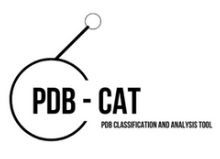 |
PDB-CAT: Classification and Analysis Tool for PDBx/mmmCIF files https://github.com/URV-cheminformatics/PDB-CAT https://chemrxiv.org/engage/chemrxiv/article-details/66b66b0bc9c6a5c07aa936de https://ariadnallopps-organization.gitbook.io/pdb-cat https://colab.research.google.com/github/URV-cheminformatics/PDB-CAT/blob/main/PDB-CAT-colab.ipynb |
| PDB-CAT is a program that classifies a group of protein structures based on their ligands into three categories: apo, covalently, and non-covalently bonded. Besides this classification, the program can verify if there are any mutations in the protein sequence by comparing it to a reference sequence. PDB-CAT is designed to be user-friendly, with its output clearly defining every entity present in each entry to facilitate decision-making. | |
 |
SARS-CoV-2 Mutation Portal http://sarscov2-mutation-portal.urv.cat/SARS-CoV-2_mutation-portal/ |
|
Saldivar-Espinoza B, Garcia-Segura P, Novau-Ferré N, Macip G, Martínez R, Puigbò P, Cereto-Massagué A, Pujadas G, Garcia-Vallve S. The Mutational Landscape of SARS-CoV-2. Int J Mol Sci. 2023 May 22;24(10):9072. doi: 10.3390/ijms24109072 |
|
| This database contains SARS-CoV-2 mutation data from the beginning of the COVID-19 pandemic. The data are derived from the analysis of more than 4.5 million complete genomes available in GISAID. Various information such as mutation type, location, % of times observed, countries, lineages, VOCs, ..... is collected. The results are displayed in tabular form and in a scatter plot. | |
 |
VHELIBS
|
|
The Validation HElper for LIgands and Binding Sites (VHELIBS) aims to ease the validation of binding site and ligand coordinates for non-crystallographers (i.e. users with little or no crystallography knowledge) by checking how their coordinates fit to their corresponding electron density map and letting the user to use models from either the PDB or PDB_REDO. The user can specify threshold values for a series of properties related with coordinates to electron density fitting (where Real Space R, Real Space Correlation Coefficient and average occupancy are the ones used by default) and, VHELIBS will automatically label residues and ligands with values within the specified limits, and the rest as either dubious or bad based on an user-configurable tolerance value. The user then is able to visually check the fitness quality of the residues/ligands to their corresponding electron density map, and reclassify them if needed. |
|
 |
DecoyFinder
|
|
DecoyFinder is a graphical tool which helps finding sets of decoy molecules for a given group of active ligands. It does so by finding molecules which have a similar number of rotational bonds, hydrogen bond acceptors, hydrogen bond donors, logP value and molecular weight, but are chemically different, which is defined by a maximum Tanimoto value threshold between active ligand and decoy molecule MACCS fingerprints. Optionally, a maximum Tanimoto value threshold can be set between decoys in order to assure chemical diversity in the decoy set. |
|
